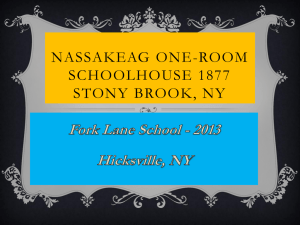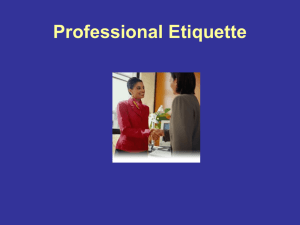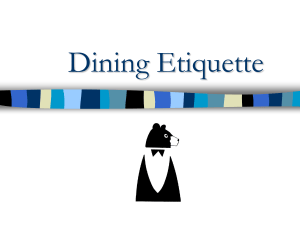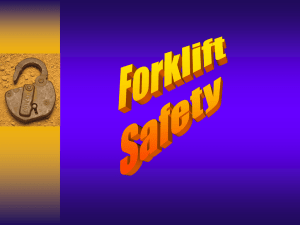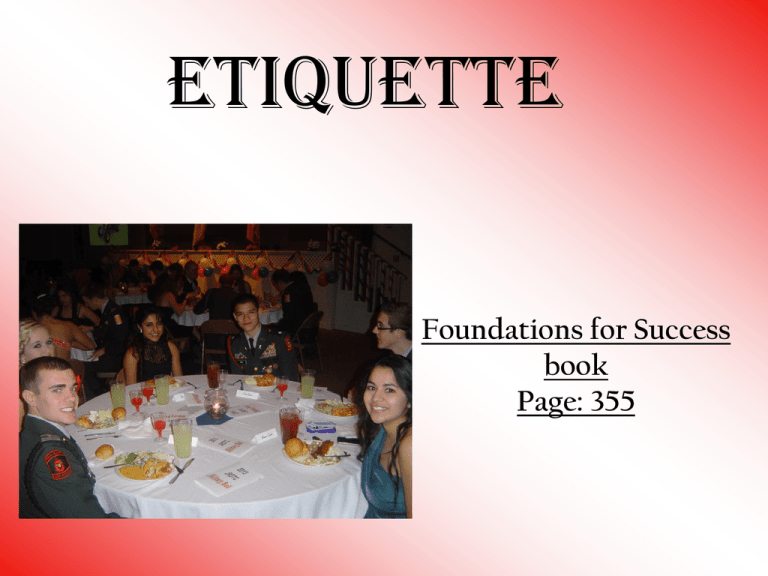
Etiquette
Foundations for Success
book
Page: 355
ICEBREAKER
1. You are given M&Ms on a
plate.
2. You must eat the M&Ms on a
plate with your fork
Reflection
• How do you usually eat M&Ms?
• How did you feel as you tried to eat
your M&Ms with a fork?
• What foods do you eat one way in
public, but eat another way at home?
Introduction
What
is Etiquette?
What you will Learn
Key Terms
What you will Learn
I will know the proper
etiquette
for various events
Key Terms
• Protocol: A code of precedence in rank and status and of correct
procedures in ceremonies; a form of etiquette observed in
ceremonies; combination of good manners and common sense that
allows for effective communications.
• Receiving line: A group of people, including the host and honored
guest, who stand in line and individually welcome guests attending a
function, at a formal reception.
• Repast: A supply of food and drink served as a meal.
• Sorbet: A fruit-flavored ice served for dessert or in between courses
as a palate refresher.
• Stag: Unaccompanied by someone of the opposite sex; traditionally,
a man who attends a social affair without escort of a woman.
• Stilted: Stiffly or artificially dignified or formal; pompous; lofty
• Tines: Slender pointed parts of a fork; prongs
Key Terms
•
•
•
•
•
•
•
•
•
Comradeship: Companionship
Curtly: Rudely brief or abrupt, as in speech or manner
Dining-in: A formal military dinner for military members only
Dining-out: A formal military dinner to which non-military guest
are invited
Etiquette: A code of behavior based on rules of a polite society
Martial: Of or relating to army or military life
Monopolize: To take exclusive ownership or control
Palate- The sense of taste
Place Cards: A name card for a formal dinner
Sequence of Events
• 1800- Pictures/ Mix and Mingle
• 1900- Receiving Line
• 1915- Posting of the Colors and Pledge of
Allegiance
• 1920- Opening Remarks
• 1922- Cadet Creed
• 1930- Toasts
• 1935- Reading of the Military Ball History
• 1940- Invocation
• 1945- Buffet Dinner
• 2045- Introduction of Guest Speaker
• 2046- Guest Speaker Remarks
• 2110- Closing Remarks
• 2120- Retire the Colors
• 2115- Administrative Notes
• 2130- Music and Dancing
Pictures/ Mingle
Pictures- Fill out the form and pay up
front.
As you Mix and Mingle
Introductions
- Example: LTC Marsh I would like you to meet
my date…. I am…
- If you are stag you introduce yourself
Receiving Line
• A group of people, including the host and honored guest attending a
function, as at a formal reception.
• All Cadets and their guest go through the receiving line.
• Ladies precede gentleman
• Gentleman introduces the lady first, then himself to Adjutant
Examples:
- Do: CPT Mann I would like you to meet my date…. I am…
- Don’t: What’s happenin’ I am… this is… oh I am…hey dude
this is…
• Stag: Unaccompanied by someone of the opposite sex; traditionally,
a man who attends a social affair without escort of a lady.
• If you are stag you should introduce yourself to the Adjutant
• Adjutant will announce your name to the host as you step in front of
them.
• Give a simple greeting
- Example: Good evening, nice to meet you
Seating Females/ Males
• Gentleman do not sit down until all the ladies at the
table have been seated
• He should first seat his guest, then seat other
ladies if needed
• Pull out the lady’s chair, then seat her by gently
pushing the chair under her.
• If a lady leaves the table, the gentleman who
seated her should rise. As she returns the
gentleman should rise again.
• Do not touch anything on the table, not even a
napkin, until after the blessing.
Posting of the Colors
• Cadets in uniform should stand at
attention
• Face stage where colors are posted
• Present arms during the Pledge of
Allegiance those in civilian attire - hand
over heart
• Everyone recites Pledge
• Remain standing to recite the Cadet Creed
Toasting
Someone will stand to make a
toast, saying…” Ladies and
Gentlemen, I propose a toast to the
United States of America.”
Everyone replies, holding drinks
up, “To the United States.” Then to
the President, Army, and JROTC.
Next, we toast “To the ladies.”
(After they are seated.)
Methods, Manners,
and Courtesies of
Eating
Punc
h
There Are Two Different
Eating Styles
•American Style
•European Style
American Style
• Cutting food should be done by holding
the fork in your left hand, tines down with
your index finger on the back of the fork,
secure the food being cut with knife,
which is held in your right hand. Cut in
front of fork, not behind. After cutting a
few pieces place the knife on the plate
and put the fork in your right hand. Also
known as the zigzag method.
How It Looks:
European Style
• Hold fork in your left hand and the knife in your
right hand. Cut and eat with your fork, tines
down, while still holding in left hand.
- Only one bite of food is cut and eaten at a
time.
- When not using your fork, rest it diagonally on
the left side of the plate with the tines down
close to the center of the plate.
Silverware
• After you have used a piece of silverware, do not
place it back on the table.
• Do not leave a used spoon in a cup; place it on the
saucer.
• Place all silverware on your plate after you complete
eating.
• Leave unused silverware on the table in its proper
position.
• If you drop silverware, do not pick it up until the meal
is over.
Napkin
• Do not tuck the napkin under your belt or wear
it like a bib.
• Napkins are for dabbing lips, catching spills,
and covering sneezes.
• Before taking a drink of water, or any
beverage, wipe your lips with your napkin to
avoid smearing the glass.
• If you leave the table during dinner, say
“Excuse me, please.” and place your napkin on
your chair.
Basic Table Manners
• Take small bites
- Do not chew with your mouth open
- Do not talk with your mouth full
• If you burp, say “Excuse me”
• Elbows, hats, gloves, cameras, purses, and sunglasses do
not belong on the table
• Your hands should go no further over the table than
necessary to eat and pass things.
• If you cannot reach something, ask for it to be passed with
a please and thank you
• If you drop something, leave it on the floor until the meal is
over.
How To Eat:
How Not To Eat:
Table Talk
• Do
- Keep conversation light
- Answer respectfully when addressed
- Be a good listener
• Don’t
- Talk too quickly or too slowly
- Yell or curse
- Interrupt
- Ridicule or laugh at an unfortunate remark or
someone’s mistake.
What to Wear: Males
• Males in JROTC wear the
Class A uniform. The Class
A jacket must be worn until
the dancing starts.
• Males who are not in
JROTC should wear a tux or
suit.
What to Wear: Females
• All females should
wear a formal Dress
• School dress codes
apply
If your Military Ball
date is not a cadet in
JROTC please teach
them Etiquette
Review
• True or False
1.
2.
3.
4.
5.
6.
7.
8.
Tines are the slender pointed parts of a fork.
A gentleman does not sit down until all the ladies at the table have
been seated.
CPT Mann I would like you to meet my date…. I am… is the wrong
way to introduce yourself and date
A gentleman introduces himself first, then his date to the adjutant
There are five toast made during the military ball
On the table there will be two glasses; one for water and one for
wine.
The American style of eating is also known as the zigzag method
Only one bite of food is cut and eaten at a time with the European
style of eating.
Review
• True or False
9. Place all silverware in your cup after you complete eating.
10. If you leave the table during dinner, say “excuse me, please,” and
place your napkin on your chair.
11. If you cannot reach something, ask it to be passed with a please
and thank you.
12. When talking at the dinner table make sure to be loud and be
heard by your table.
13. Males in JROTC wear the Class A uniform. The Class A jacket
must be worn until the dancing starts.
14. Females may wear a dress that does meet the school dress code.
15. When a cadet is STAG the cadet should introduce themselves
throughout the night.
THE END



